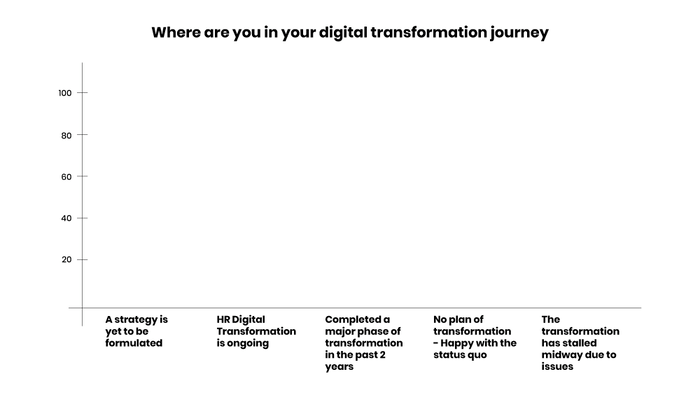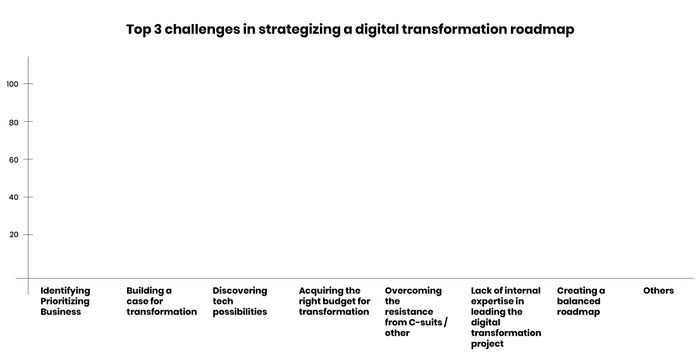
“Digital transformation is the smart integration of digital technologies to create new or modify existing business processes, culture, and employee/customer experiences to meet changing business and market requirements”.
Two third of the business leaders believe that if their company doesn’t digitise by 2020, then it will no longer be competitive. Interestingly, HR that was viewed as a support function that delivered employee service alone is now trusted as the kingmaker for organisations to drive their digital transformation journey.
According to a Gartner report, 87% percent of senior business leaders say digitalization is a company priority and 79% of corporate strategists say it is reinventing their business creating new revenue streams. And 80% of the organisation headquartered in APJ, plan to deploy new cloud digital technology in HR by 2021.
According to a quick on-spot survey by Darwinbox, when asked about the stage of digital transformation they were in, 71% voted that their digital transformation journey is ongoing which indicates how every organisation is looking to adopt technology and make it as a competitive edge.

Anirvan Mukharjee, CHRO of CGI says, “We have started our digital transformation journey, and are empowering the managers with recruitment self service. However, we are still awaiting to implement analytics which will help us make sense of what we are doing, which is ongoing now.”
Roadblocks Faced In Strategizing A Digital Transformation Roadmap:
According to an active poll during a CHRO Dialogue hosted by Darwinbox, we collected inputs from 64 respondents, and these came out as some of the top challenges in strategizing a digital transformation roadmap.

Getting Ready For a Transformation:
Rattan Chugh, ex-Chief People Officer, Times Internet from his experience on how Times Internet prepared for a smooth transformation says, “Once the need for change was visible, , we immediately got the leadership buy-in and presented a business case to the major stakeholders. We also realised the need for accurate data which was a major challenge we were facing previously because of the multiple systems at play .”
The need for HRs to understand their business requirement and talent needs first, and then the HR tech market for digitalization is fundamental.
Shift In Mindset To Create A Digital-Ready Culture:
As is rightly said, “change is inevitable and evolution is the essence of the existence of life on earth”. It is therefore very critical for the leadership team of any organisation to drive the change along with HR leaders who are critical in their role in changing the mindset of the people across the organisation. Digitalisation is not a one man project, neither is it a IT or HR project. It is a corporate initiative. IT and HR can help in bringing their expertise to implement the process, however, the entire initiative has to be driven and adopted by all employees in the organisation.
Investing in a technology and the best in class tech might not amount to the digital transformation success. ‘People’ are the most important asset to attend to and communicate with when strategizing for HR’s digital transformation journey.
Plan Digitalization At Your Pace:
The People Practice Lead at Cure.Fit while sharing their transformation roadmap says, , “From an employee experience perspective looking at digital journey, are there other revenues that we can solve for because that’s one big factor for us at Cure.fit when we are looking at HR transformation.”
He highlighted three major milestones a roadmap should have:
- Identifying and prioritizing business objectives: Business objectives and strategy vary for various organisations. Some might be solving for control and efficiency, while others might be inclined towards employee experience.
- Building a solid case for transition & securing stakeholder buy-in: When building a case for change, it is vital that metrics should be driven by objectives. All the major stakeholders should be involved and the HR team should take everyone along.
- Choosing the right tech possibilities: The important thing to remember is that no one size fits all. Therefore, organisations should choose technology partners based on the organisational context.
HR’s major focus should be to solve for employee experience, monitor and analyze the data and rebuild the processes accordingly. It is ideal for HRs to empower managers as they spend most of their time with employees. Rather than focusing on transactional pieces.
CEO’s Expectation From A Digital Transformation:
CEOs should play a strategic role marketing the strategy and defining the vision for future culture of the company. It is imperative for the CEO to communicate the value proposition of the transformation journey. CEOs are expected to champion the transformation’s mission and define leadership responsibilities. Today as most organisations work on numbers, data and analytics, here are few other points which are on the CEO’s mind which should be taken care before implementing a transformation journey.
- Centralised Data- Availability of correct data for instant course correction
- Analysing Pulse- Sensing the mood of employees by conducting surveys
- Intelligent Automation- Solving the right issue at the right time with the help of smart tech.
- Seamless Collaboration- Helping functional teams cross-collaborate.
One of India's largest consumer oil companies, Adani Wilmar planned and digitised their HR processes for 2500+ employees. Know how


Speak Your Mind